|
|
|
Note: This part of the webpage is only
a supplement or an addition to the excellent book: Sturmgewehr 44,
by Dieter Handrich and to Paul Peter Pöllingers 3 books recently published: Zubehör (accesories) zum StG44 Teil 1 Magazine, Teil 2 Magazintaschen (pouches) and Teil 3 other kinds of Zubehör zum StG44.
The MP44 / StG44
The MP43 / MP44 / StG44 are essentially the same gun. For some unknown reason
the MP43 was officially renamed to the MP44, April 25, 1944, and the MP44 was again renamed to the StG44,
October 22, 1944. StG means "Sturmgewehr" - "Stormrifle" or "Assaultrifle". This last designation
must have been made in propaganda considerations. The new names weren't effective until much later.
The MP43 was produced from Dec. 1943 to 1945, and the MP44 was produced from 1944 until the end of the war.
The StG44 was produced in 1945 only. Which name is correct? One could argue that the StG44 was the last used - and then the correct one,
and other could say that the majority of these gun were marked MP44, so the common name should be MP44. One of the four
producers used only the designation: MP44. (In fact there exist a few MP45. One quick-witted person may have thought: We have made
MP43, last year we made MP44, and now here in 1945 it must be MP45).
German army studies had shown that few combat engagements occured at more than 300 m and the majority within 200 m. The German standard
ammunition - 8x57JS - was capable to kill beyond 1500 m. A rifle fired that ammo in shot bursts was impossible to control
- a lesson taught also with the AVT40, FN FAL, HK G3 etc. The MP40 - using 9 mm parabellum ammo - was easy to control, but only effective
at shorter distances; perhaps 20 m and indeed not 200 m. So the Germans invented a new cartridge: 8 mm kurz. Same diameter as the 8x57JS but
much shorter, 48.0 versus 80.6 mm. This new ammo was the vital part of the succes of the MP44 / StG44. See more about the "kurz"
here.
Generally accepted as the world's first assault rifle, the StG44's effect on post-war arms design was wide-ranging, as seen with
the Russian AK47, and more than 15 years later in the U.S. M16 and other rifles in cal. 5.56 mm.
One can ask the question: What about the "war baby" born at the same time on the other side of the ocean - the U.S. M1 carbine cal. .30? More than
6 million made. Didn't it inspire weapons constructors. The answer is: not much. The problem was the ammunition:
| Energy/Joule: |
9mm para MP |
U.S. M1 carbine |
8mm kurz |
7.62x39mm Rus. |
5.56mm Nato |
7.62mm Nato |
8x57JS / sS - K98k |
| 0 meter |
556 |
1324 |
1877 |
1991 |
1867 |
3292 |
3648 |
| 100 meters |
399 |
848 |
1328 |
1417 |
1503 |
2763 |
3190 |
| 200 meters |
286 |
541 |
919 |
1009 |
1204 |
2291 |
2791 |
| 300 meters |
205 |
377 |
634 |
718 |
954 |
1882 |
2428 |
The carbine didn't have much power beyond 100 - 200 m, so it couldn't be used as a "stormrifle"
- only as a weapon for personal defence.
The whole concept was born as MKb42 - Maschinenkarabiner 42. Both Walther and Haenel made prototypes but
the Haenel design was preferred. After some minor changes - such as change to closed bolt firing - the new MKb42(H) was sent to the field late in 1942, where it
was well received by the users. The troop trials resulted in the new MP43/1. It fired from a closed bolt, had a dustcover, a longer handguard
and
no bayonet lug. Hitler rejected the project several times in 1942 - one of the reasons was
the use a new type ammunition. In Feb. 1943 the MP43/1 was demonstrated for Hitler. He turned pale when he saw it: "Now
you come with the same stuff again which I don't want to see anymore, even though you gave your baby a new name." However, Hitler's ban was
ignored by the Supreme Command of the Army - and troop trials continued. (this and other information are partly taken
from H-D Handrich's book).
Finally in Oct. 1943 Hitler agreed that the MP40 should be replaced by the MP43. The change has to occur
expeditiously. Note the name change: MP43 - the final production version. It had no rails for a scope mount and a slightly different
barrel at the muzzle - see further below. The MP43 should only replace the MP40. The switching from K98k to G43 production
should continue with emphasis on the scoped version.
Haenel was the only factory to produce the MKb42(H) (about 10,700 made) and the MP43/1 (about 24,600 made). Late in
1943 Haenel began to produce the MP43. The MP43 production was followed by Erma, Sauer and Steyr in 1944. Steyr made very few MP43 before the nomenclature
was changed in April 1944. Haenel, Erma and Sauer gradually change the name to MP44 during 1944. And Haenel, Erma and Sauer started
to mark the guns StG44 in early 1945.
The lugs for mounting a standard K98k bayonet disappeared with the MKb42
- (who could imagine bayonet fighting with an assaultrifle?). The scopemount-rails were last seen on the MP43/1 and the early
MP43, because the G43 was given prority as sniperrifle with the the ZF4. Tests had shown that the MP44 was not usable for sharpshooting.
Finally about October 22, 1944 Herr Hitler resolved that
the MP44 - now named the StG44 - in the future should replace the K98k (and also the MP40) as the weapon of German infantery.
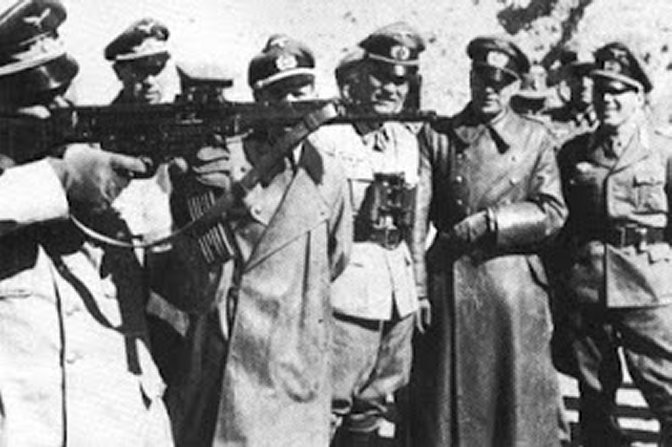
As said above the MP43, the MP44 and the StG44 were essentially the same. Some minor modifications happened during the short
production run from Dec. 1943 to May 1945 such as omission of the threaded muzzle and a not so high stock (Einheitskolben - standardstock).
The rifle was rather heavy, 4.6 kg incl. an empty magazine, compared to the weight of a K98k: 3.9 kg. The weight wasn't much appreciated by the soldiers - especially with
all the ammunition,
but it made the gun rather easy to control during rapid fire. The reason for the high weight was
the needs of the war which dictated the use of available non-priority steels so
the rifle was made of heavy stamped and welded steel.

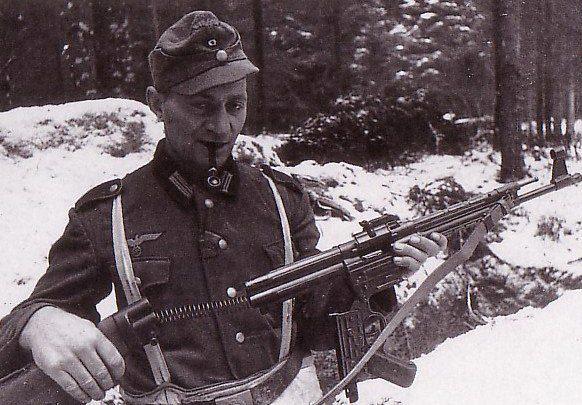
The good news was that it was easy to maintain, lubricate and assemble. In sharp contrast to the G43 with it's many pins,
washers and springs - and an impossible to assemble extractor. The disassembly of the German G3 was directly copied from the StG44. The crossbolt was removed,
so the trigger-housing could swing down. The buttstock was removed backwards incl. the recoil spring.

Official papers indicate that the line of sight was about the same as for a K98k. It's difficult to understand seeing
this photo, where the firer's head is much exposed, when the magazine is resting on the ground. Note that both the muzzle nut and the
scope mount are very unusual - presumed prototypes.
If single shots were to be used, the selector should be pressed to the left side so "E" was visible - and to the right side so
"D" was visible if the shooter wanted to fire in bursts. Fire discipline was mandatory. "On priciple individual fire is to apply
to individual targets. However, if a decision is necessary, e.g. in defending against an enemy attack at close range, the highest rate of fire
in the form of burst fire is necessary. Burst are to be restricted to 3-4 rounds. Continuous fire is not allowed and would only mean a waste
of ammunition. The gunner must be trained so that he fires only deliberate individual fire at favourable moving targets."
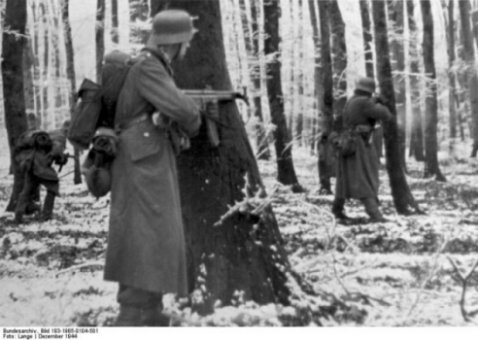

See above a pair of photos from the beginning of "the Battle of Bulge" in Dec. 1944. It appears as the "press coverage" on that occasion was
better than on the Eastern front.
Production began with the first batches of the new rifle being shipped to troops on the Eastern Front. By the end of the war, a total of 425,977 (436,000? incl. April 1945) StG44 variants of
all types were produced. The assault rifle proved a valuable weapon, especially on the Eastern front. A properly trained soldier with an StG44 had an improved tactical repertoire, in that he
could effectively engage targets at longer ranges than with an MP40,
but be much more useful than the Kar 98k in close combat, as well as provide covering fire like a light machine gun. It was also found to be exceptionally reliable in the
extreme cold of the Russian winter. The allied could count themselves lucky that the StG44 wasn't more used by
the Germans. This would have cost many lives.
In the Russian TV series Soviet Storm it's explained: German defence was traditionally built around the MG34 or MG42 machinegun.
The rest of the infantry squad - armed with K98k rifles - was effectively there to support the machinegun team. By autumn 1943, the Red Army had developed tactics for attacking German infantry.
Soviet rifle platoons, supported by artillery and mortars, aimed to wipe out enemy machinegun positions in the first few minutes of the assault.
The remaining rifle-armed Germans would be seriously outgunned by Soviet troops armed with submachineguns.
But from late 1943, the Germans began to change the balance once more, with the introduction of the MP43.
Now if the infantry squad's machinegun team was knocked out, a squad armed with the new MP43's could still provide heavy, accurate fire against enemy attackers.
MP43
Below a MP43 made in 1944. Identical to the MP44 and StG44. We don't know how many were marked MP43, as the production
was mixed with the two other markings. See further down a possible explanation of why some MP43 were made very late.
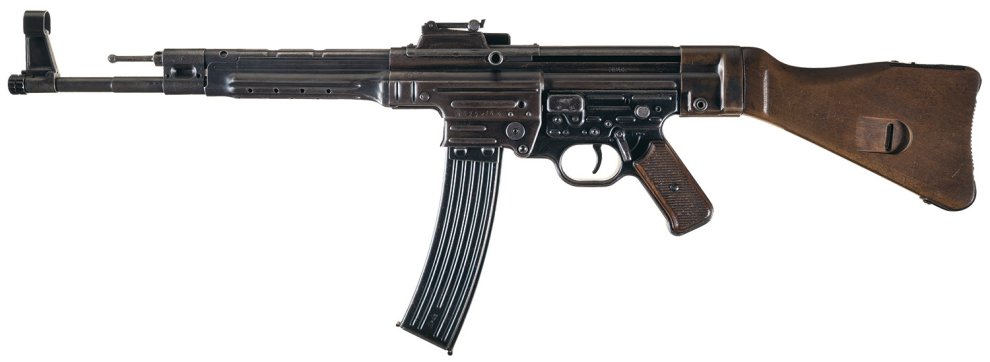
Specifications: Weight: 4.6 kg (10.2 lb) unloaded with magazine, 5.1 kg (11.3 lb) loaded, Length: 940 mm (37"), Barrel length: 412 mm (16.2"), Cartridge:
7.92x33 Kurz (aka 7.9mm Kurz or Pistolenpatrone 43), Action: gas-operated, tilting bolt - full auto or semi auto, Rate of fire:
550 - 600 rounds/min., Velocity: 690 m/s (2.264 ft/s), Feed system: 30 rounds detachable magazine, Sights: rear adjustable sight, V-notch
up to 800m, front: hooded post.
MKb42(H)
Below a fine MKb42(H). Only 10,700 were made and most were lost on the Eastern Front. This example here - with a rather high
production number - doesn't have a
bayo-mount. The magazine is marked MKb42.
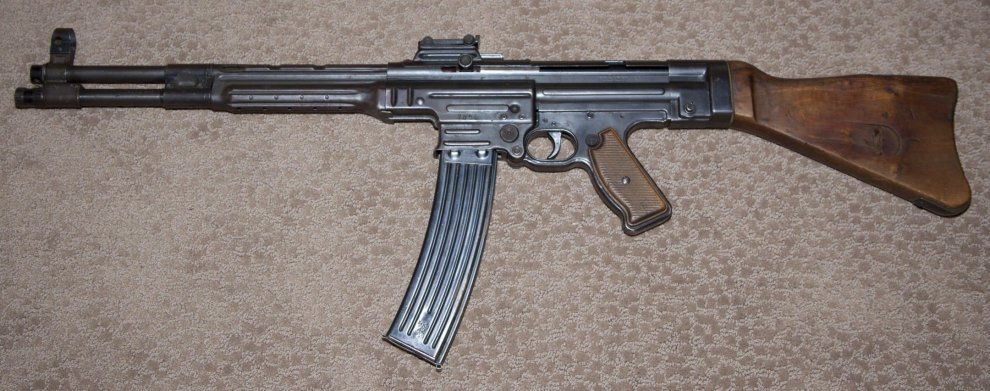
Shooting a fully functioning MKb42 A 15-round magazine is used. Note it's possible to control it during the burst.
That wouldn't have been possible with a 7.62 Nato cal. rifle.
MP44 scopes
Two different scopes and mounts were
tested for the MP44 series of guns but none of these were
actually produced because these guns had a shot dispersion which
was so great that they couldn't replace the G43 as a sniper
rifle:
MKb42, MP43/1: Had integral scope mounting
rails at each side of the rear sight. A scope mount like the
mount on a G41 was intended for use but was never produced. A
prototype MKb42 is seen with a ZF41 - see below. See also a
MP43/1 with integral scope mount (with a notch - the later
models didn't have this notch)
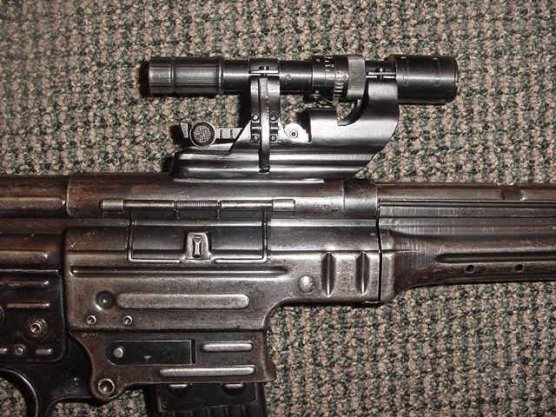

MP43/1: A few had a scope
rail spot-welded to the right side of the main housing. The
steel base was almost identical to the integral G43 / K43 scope
rail, but the MP43/1 wasn't found
usable for sharpshooting. The main reason was
that the fastening of the mount rail on the right side of the receiver caused
irregular vibrations. Only the affixing of the mount rail on a more solid part would have brought improvements.
Another thing was that the "kurz" ammo wasn't especially suited for sniping.
The scope rail was later used with the "Vampir" infra red
setup.
See two pictures below of a MP43 made in 1944:
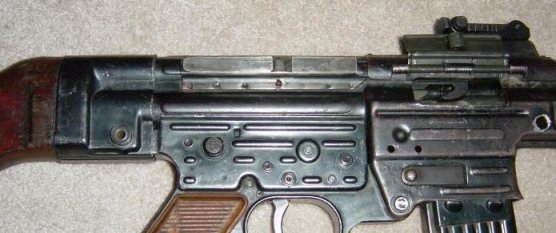

Below a MP43/1 made in 1943. The ZF4 rail is not spot welded like others but welded
across 2 small areas of contact on the receiver. The rail is marked with a Sun symbol. According to "the Sturmgewehr-book"
21 MP43/1 were subjected to trials by the Infanterieschule. The MP43/1 below must be one of these.
However, most were with spot welded rail.

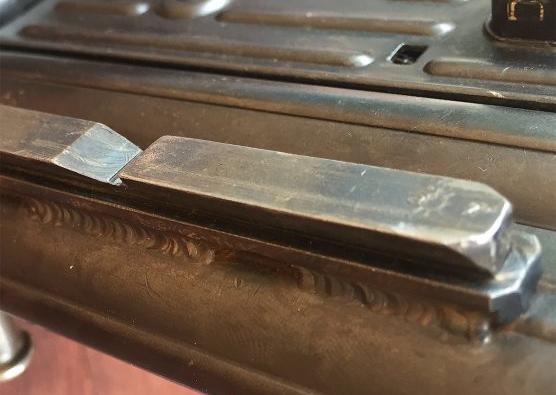
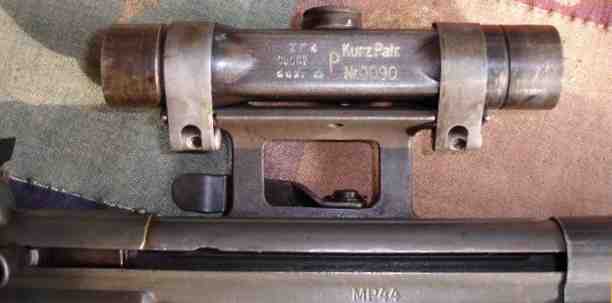 Above a ZF4 marked for use with kurz round. I am not
sure about the origin of the mount. A special ZF4 was used
for the "kurz Patrone" (because of different trajectory). See below two photos of a "P" scope. Note that the elevation knob
has a maximum of 600m versus the normal 800m. The marking: Kurz Patr. Nr.00XX is not believed to be genuine.
Above a ZF4 marked for use with kurz round. I am not
sure about the origin of the mount. A special ZF4 was used
for the "kurz Patrone" (because of different trajectory). See below two photos of a "P" scope. Note that the elevation knob
has a maximum of 600m versus the normal 800m. The marking: Kurz Patr. Nr.00XX is not believed to be genuine.
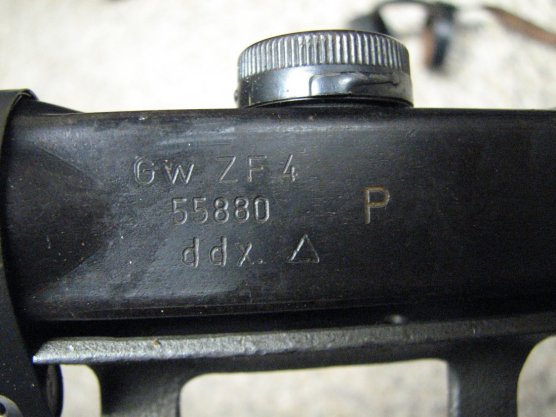
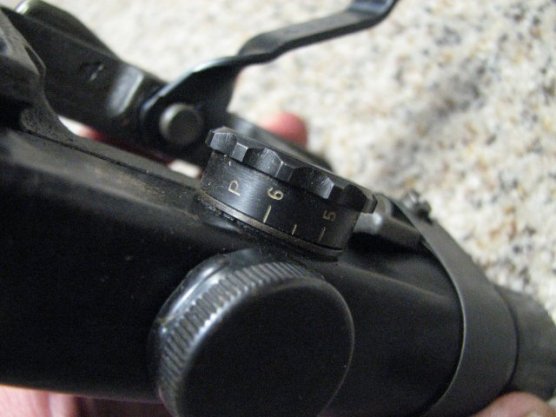
Video clips
Battlefield: The Battle of Normandy S1/E5 - 3m28s
Battlefield: The Battle of Berlin S1/E6 - 1h04m05s - 1h22m36s
Shooting a fully functioning MKb42
MP43/1
Note the scope rail below the rear sight. The
scope rail had no notch. Some MP43/1 (the first) had scope
rails with notch and the last didn't have scope rails at all.
The MP43/1 had a special long muzzle nut.
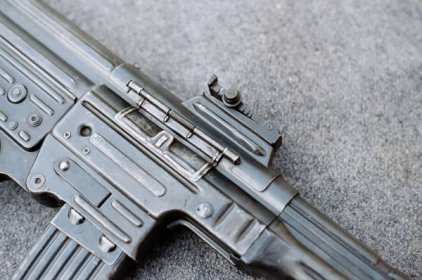

MP43/1 accessories
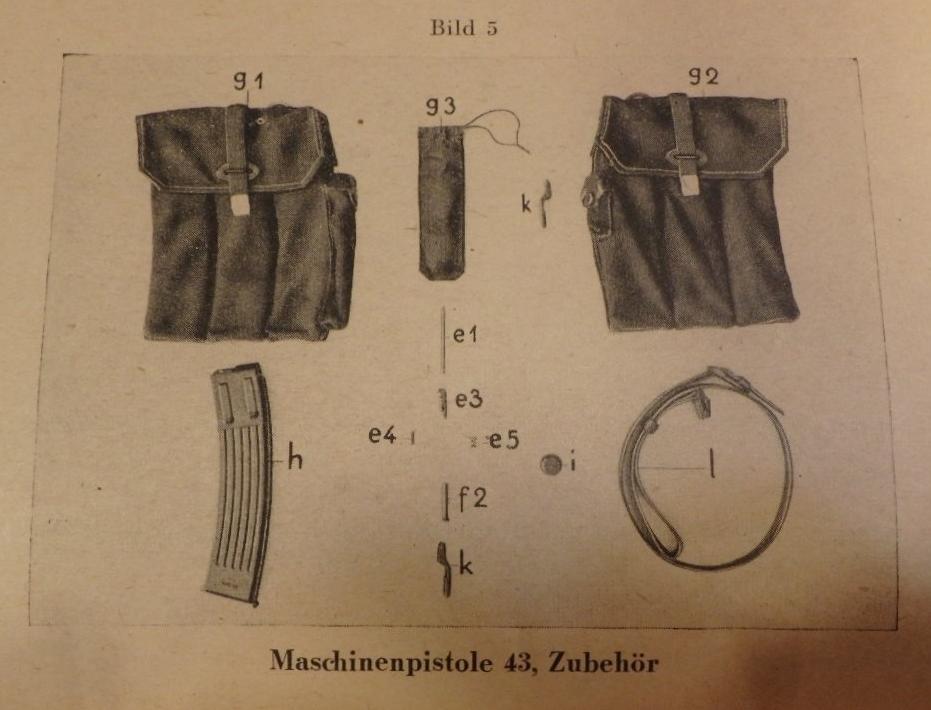
e1: Firing pin
e3: Extractor
e4: Pin for the extractor
e5: Extractor spring
f2: Butt stock retaining pin
g1: Left pouch
g2: Right pouch
g3: Spare parts bag
h: 30 round magazine
i: Muzzle cap
k: Magazine loader - mentioned twice ?
l: Carbine sling
The picture looks pretty much the same picture for MKb42. The same pouches; the same magazine - looks like one
of the first M.Kb.42 magazines. Note also that there is no take down tool.
MP44 magazine loader
|
The upper magazine loader is
original. The lower is a repro. Note it's bent incorrectly so
it's impossible to press the ammo down into the magazine.

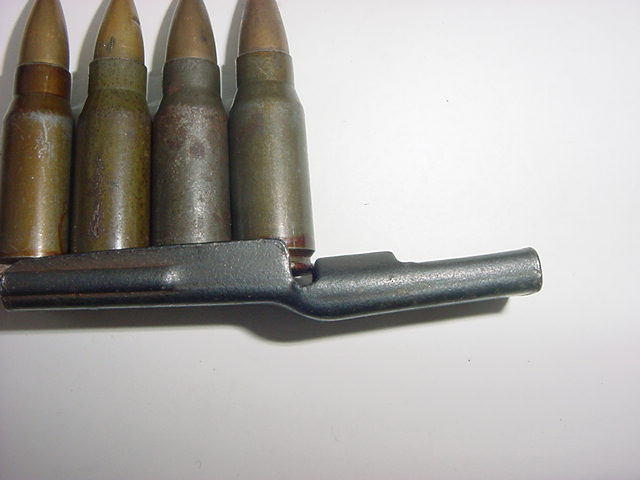
The original loader to the left. It isn't presumed that the original loaders were WaA-marked (749).

Take down tool
The lower is original. It's
difficult to tell the difference.

|
Spare parts bag
Made of rubberized fabric - original.
Contains: firing pin, extractor, extractor pin and extractor
spring. |
One of the last MP44 made
Three finishes: 1. Blueing, 2.
Phosphorus, 3. Bare - nothing on the steel.
This weapon was taken from a German factory (not a MP44 factory) in the area of Aachen in
1945, from a crate with many others, it was never issued. Like new!!

The unique MP45
I have only heard of two MP45's - a
misprint could be the explanation of one of these just as the MP45 marked magazine you can see further down. The other was made by
Haenel with a special simplified receiver. It was planned to put this into production as MP45 - but it was never realized. The new name "MP45"
must have been given before it was decided to rename the whole idea as StG. (in Oct. 22, 1944)
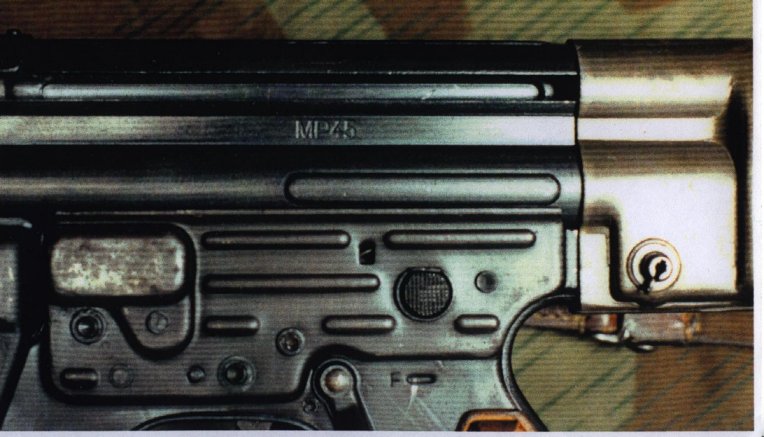
Trigger groups
The trigger groups were produced by two factories.
They were produced completely assembled and separation was not foreseen. If
there were problems, the whole housing should be removed (by pressing out the pin).

Wuttembergische Metallwarenfabrik, code "awt" and WaA21 produced trigger groups during the whole period
MKb42 - StG44, and National Krupp Registrierkassen - WaA254 - from 1944 - 45.

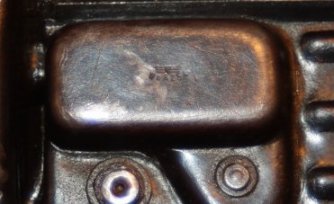
Within the trigger group some pieces could came from subcontractors marked: aqr, ce, v, fxo, pa, cnd (National Krupp R.),
etc and WaA37 or WaA359 etc. A good infrastructure and unobstructed production at each individual plant was necessary for the final assemembly of the
"Sturmgewehr". A look at GunBroker shows that many parts were overstocked such as many trigger group parts, gastubes etc.
|
Different stocks
A MP43/1 to the left. A late MP44 to the
right. The hole for the recoil spring is 1 cm deeper in the
MP43/1 stock + the spring is longer and has 3 coils more.

From left to right: MP43/1, unknown model and late MP44. The "Einheitskolben"
- on the right side - was made as standard after the summer of
1944. The "Einheitskolben" maybe fitted to the same hardware in
vehicles as the normal Karabiner98. See on the right side a
photo of late war stocks - some without ribs; all of these are
laminated.
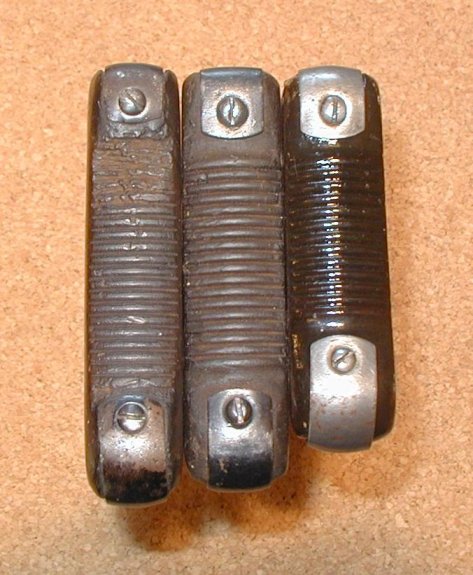

|
Stocks without spare parts
compartment
A few "Einheitskolben" are seen
without the trapdoor. These stocks have a number at the
bottom (most probably added after the war) and the letters "JC" or "ac" - or more probable
reversed "ce" on the left side in front of the sling
slot.
The next photo shows the normal stock with the small
booklet and tool.
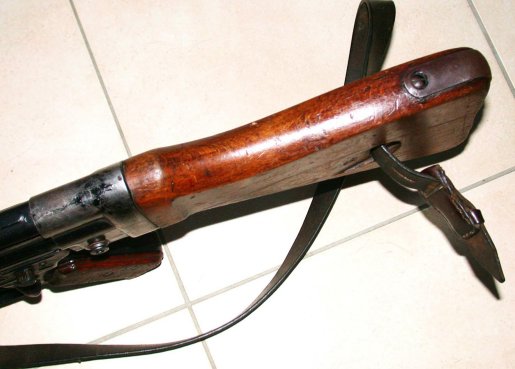
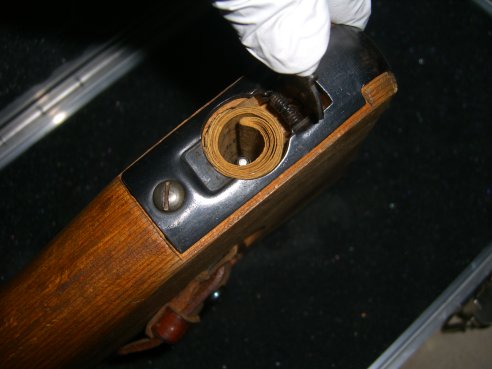
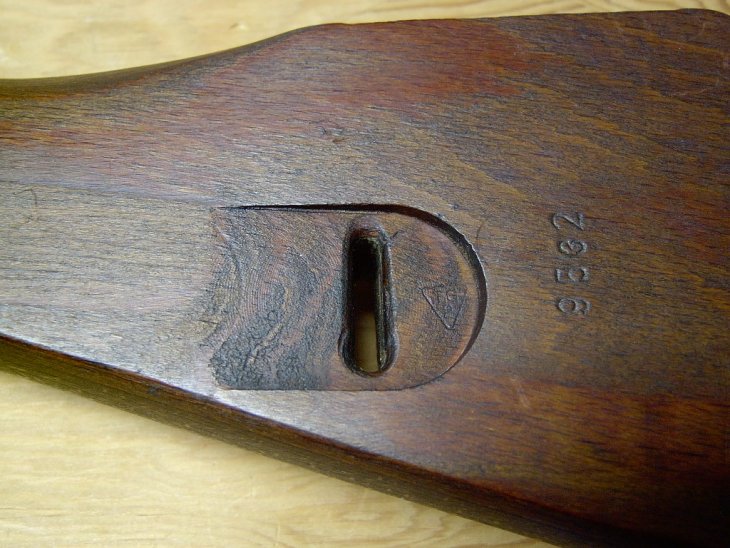
The stock above is serial numbered - not original Wehrmacht made. The stock is marked "TG2". Some say this means:
Tschekisches Gewehr fabrik (Czech rifle factory) - the code can also be: "tgf" - but it isn't easy to understand
why the Czechs should use a German name after the war.
Improved bolt
The improved bolt - left - has a large
diagonal relief beneath the exactor (removed here) to
accumulate residue. Picture in the middle: a MP43/1 bolt. There is no slit for the extractor spring.
The bolt for the MKb42 is possibly the same. To the right:
Note the edge on which the extractor rests.
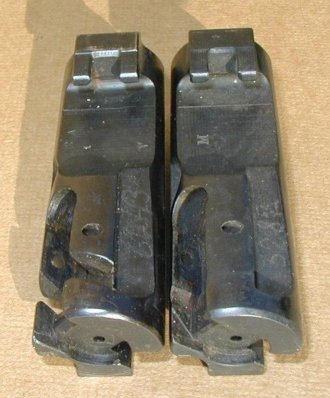

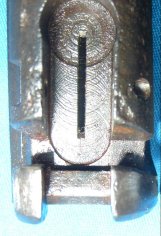
Extractors and firing pins
Below some examples of extractors. The left doesn't look original. A new extractor was put in
production in 1944 and some hand fitting was necessary if the a new extractor should be used in an old bolt. Apparently
this change was made in conjunction with the addition of the transverse groove.
The first firing pin with 4 sides is for the MKb42. The next two triangular firing pins are original MP44 firing pins; first with radiused curves, later with flat sides. Because
of risk of slamfire the firing pin must be as light as possible. I believe that the last firing pin was made after the war.

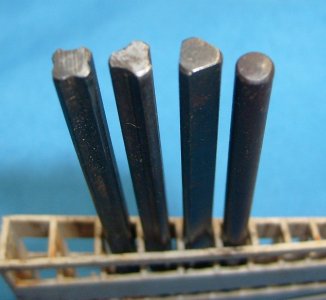
Below another row of extractors. The first on the left is marked "Erb" with a crown on top (just like parts from WW1 ?).
The next 3 VK marked ones are Yugo. The fxo ones are German; perhaps also the ms marked. The last 6 are unknown.

Magazine release button
The checkered type of button was used in the beginning - later appeared the
raised ring version - simpler to produce.


A StG44 magazine with an
U-construction
It's marked: STG44, qlw and WaA892.
The type is seen with Czech post war markings: E46 - in
some cases E46 over stamped the German marking but this
here has only the Wehrmacht codes.
Note here the U-construction instead of the normal
pattern with two half stampings.

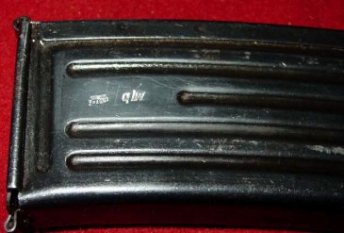
Another special magazine
It's marked MP45 to one side and
gqm WaAA98 to the other. I guess such a magazine is
produced at the beginning of 1945. They have perhaps
thought: We have had MP43 magazines, last year we
produced MP44 magazines; now we are in 1945 - so this
must be a MP45 magazine ? MP45 magazines are only known
with the code gqm.

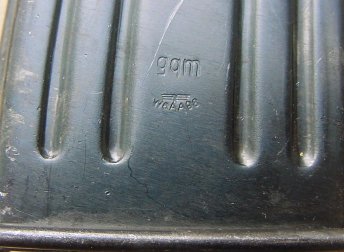
A 10 round magazine
One would be inclined to think
that a 10 round MP44 magazine with only a production
code on the floor plate is a post war fake. But
something indicates that such a magazine was made in a
limited quantity during the war - perhaps for the Mauser
made Stg45M (Gerät 06), which never came in production
and always is pictured with a 10 round magazine - (or
the soldiers themself shortened 30 round magazines to
avoid a high shooting position).
I got the first 3 photos from a well-known MP44 magazine
collector. He bought it in 1990 for 150 $. It was the
only one in a batch of several hundred magazines. The
only marking is "CHN" on the floor plate.
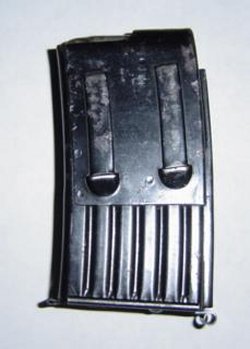
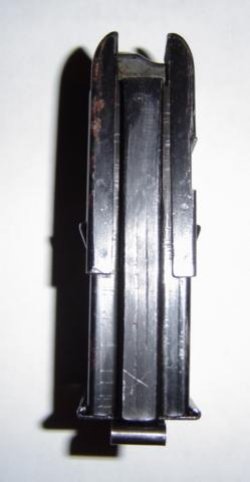
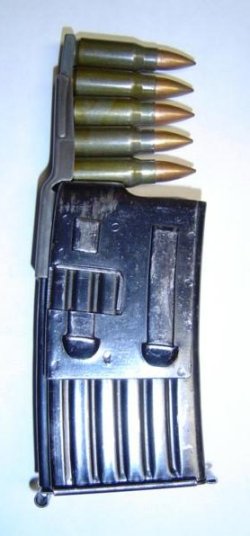
The next photo is a "Bodenfunde" (grounddug) from
Poland. It looks like it has been in the earth for
several decades.
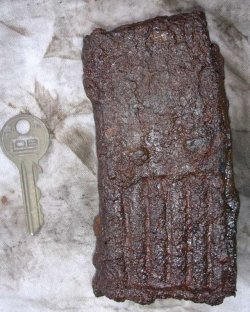
Again next a complete MP44 with a short magazine.
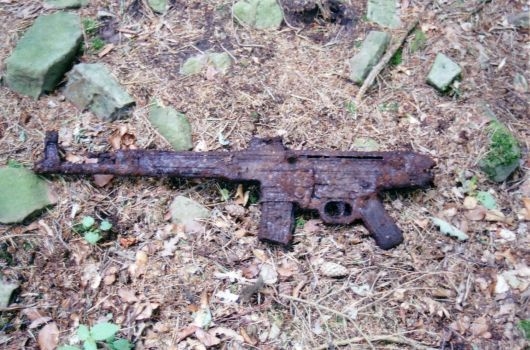
Then you see two photos of 100 % relic from the battle
of Bulge - found in a barn there. This magazine appears
to be very short. I think it's front-made modification.


A magazine was seen on eBay in
2006. (description: the magazine was produced for the Stg45M - of
which only 4 were made - Mauser tried to salvage the
Stg45M, but they were bombed in a train in Austria the
last days of the war). The fact is that the Germans decided late in the war to transfer
production equipment away from the front line and allied bombing. On April 19, 1945, a
train with 29. box cars departed from Oberndorf, heading for the Alps. There were production equipment
for a monthly production of 20,000 K98k, blue prints, models, personnel, etc. On April 30,
the Odyssey stopped in the Austrian Alps. The project was hopeless and only a few boxes were unloaded. So it's
very possible that the shown magazine really was made by Mauser.
Mauser's Geraet 06 / StG 45 (M) is usually shown with a 10 shot magazine. Probably it was planned to use a
30 shot magazine, but initially they used a 10 shot magazine simply because they couldn't use a 30 shot magazine in
Mauser's shooting machine.(source: Handrich, Sturmgewehr 44, 2.nd edition, page 294)

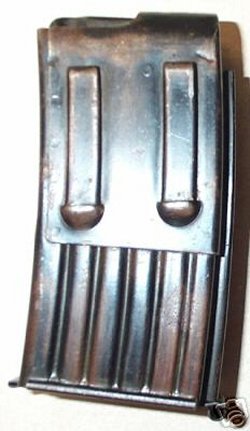
An original? 10 shot magazine
New old stock. 2 magazines were on eGun in the
beginning of 2022. The text was: Rarity from a hoard of a former depot
Factory Combat Groups of the DDR -
in the original packaging, probably hardly used.
The magazines are not just shortened 30 round magazines. On the left side the type (MP44) and on the right side
WaA37 and the producer (fxo = Haenel). The floor plate is marked fxo.
Are these magazines genuine Wehrmacht or just outright fakes?
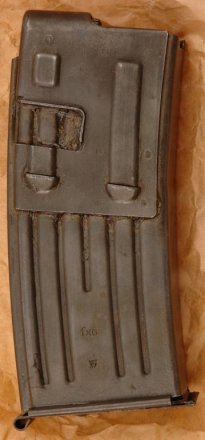
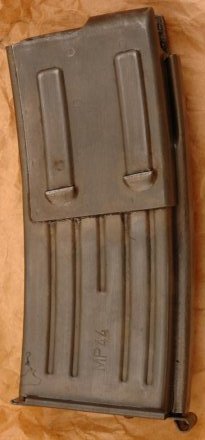
Unoriginal? 10 shot magazines
The never ending story about 10 shot magazines. Seen on eGun in
middle of 2022.
The magazines are not just shortened 30 round magazines. On the left side the type (MP44) or (StG44) and on the right side
WaA255 and the producer (ctd = Anton Reiche). The floor plate is marked ctd.
Are these magazines just outright fakes or perhaps genuine Wehrmacht? I think they are in the fake category because
1) The WaA255 looks strange and 2) a ctd marked floor plate has never been seen before (now).
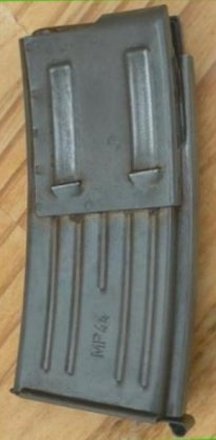
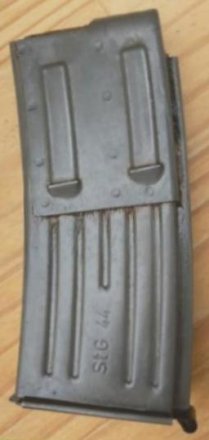
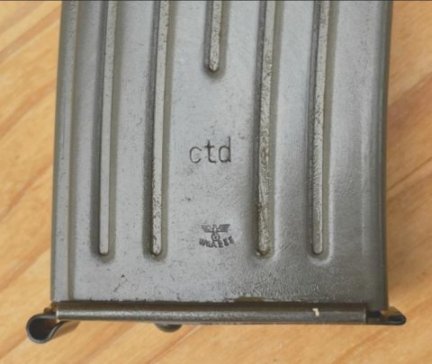
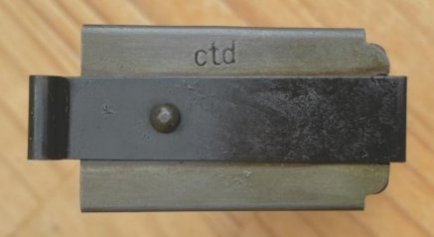
A double magazine
Probably a front line modification. That way it was possible to quickly change magazine
- almost equivalent to a 60 shot magazine. It could not be in the magazine pouches so it should be permanently on the weapon.

Does a special MP44 sling really exist ?
See more on the "Sling section"
A special late MP44 sling - no
This Steyr produced MP44 was
found with a dead German soldier near Besançon. It has a strap and a D-ring
from a gas mask. It has been said that the last produced Steyr MP's were provided with
gas mask straps instead of the normal leather karabiner sling.
See pictures below: (Collection E.F.W.)



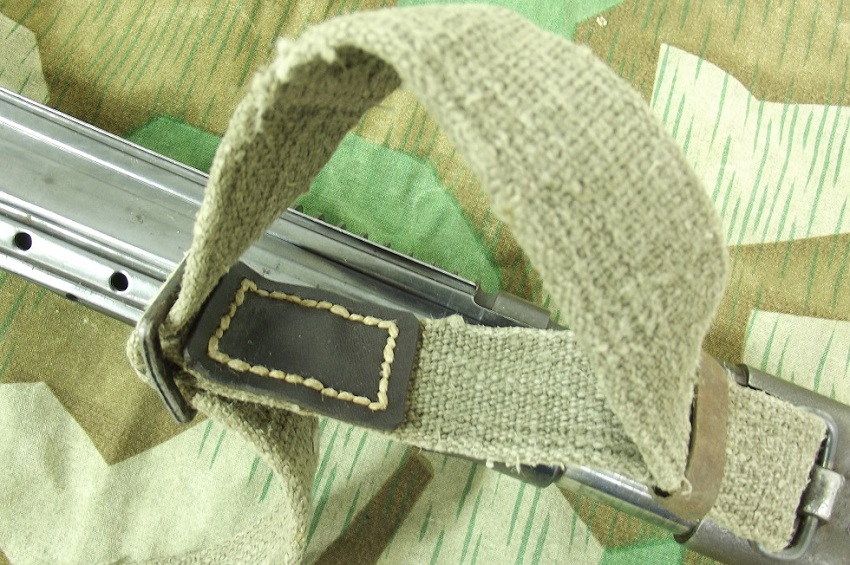
The manuals
1. D1853/2 from Feb. 25, 1943 MKb42 (H)
2. D1854/2 from Aug. 31, 1943 MP43/1
The manual has 35 numbered pages.
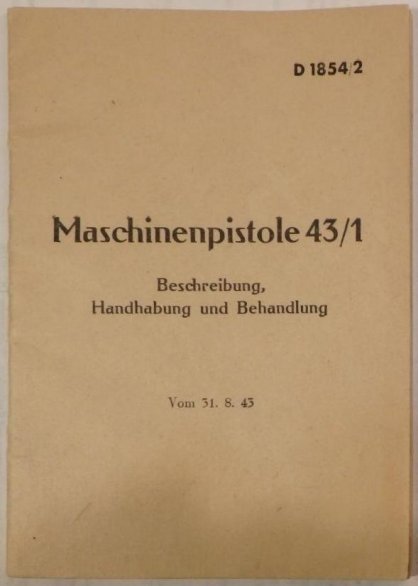
3. D1854/3 from June 3, 1944 MP44
4. D1854/3 from Dec., 1944 StG44
The Dec., 1944 edition was a reprint of the June edition. The only change was the new name. No MP43 buttstock manual was made. These small buttstock manuals have only 16 numbered pages,
so they contain not so much information as the two earlier manuals.
Click on the picture below to see the last manual:
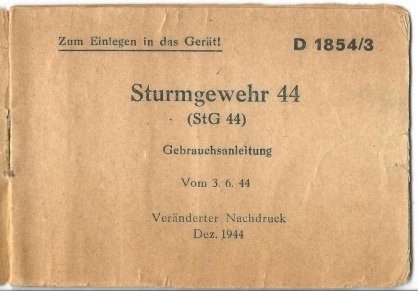
From a Soldbuch
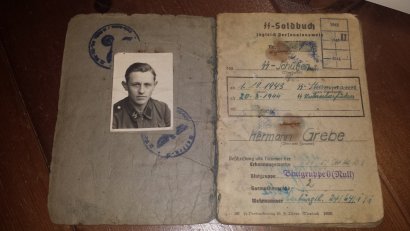

Click above images to enlarge - the soldier was first issued with MP38/40 and then at last with a MP44.
And another Soldbuch
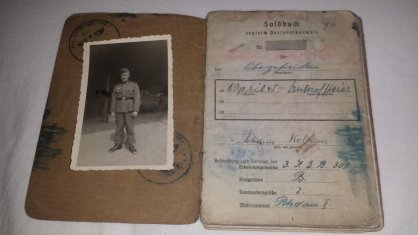
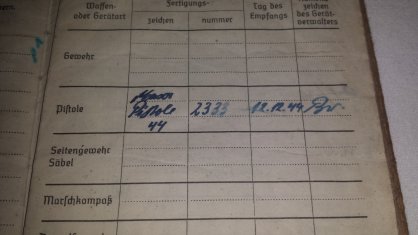
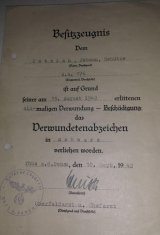
Click above images to enlarge - the soldier was issued with a MP44 #2333 Dec. 12, 1944. He was wounded in Stalingrad - got a wound badge, and participated in the
Battle of Anzio and later in several fightings further north in Italy. Was alive April 1, 1945.
A MP44 flash eliminator
Most probably made after the war
(Etzel sold them in the early nineties for 150 DM). Some
have nazi eagles and WaA63.

A flash eliminator seen on a Hungarian
auction

The MP44 was the ancestor of weapons
made after the war; especially AK47 but HK93
here - 30 years later - has the same basic characteristics as MP44. Separation
of the main parts is also the same for the two weapons, but the internal functions
are much different. (I doubt that the HK93 was an improvement in that respect)
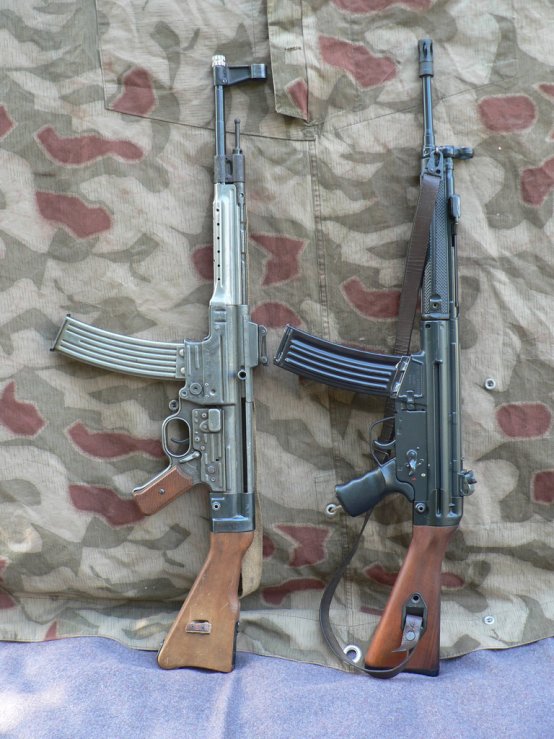
CB51 - made in Spain
A semi-automatic rifle in cal. 8x33.

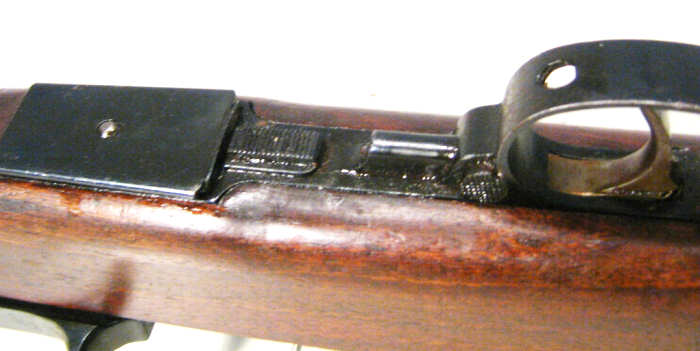
CAM 1 - The Argentinian MP44 copy
Only 3 were produced. Some more information about this rare weapon here.
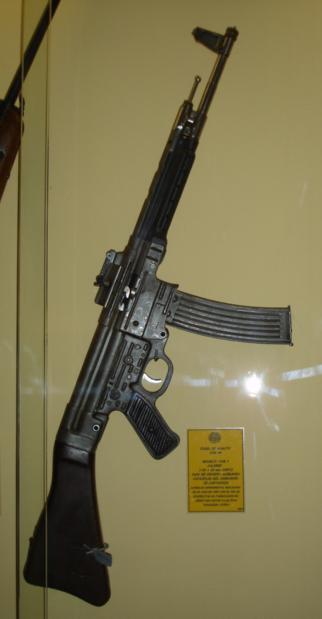
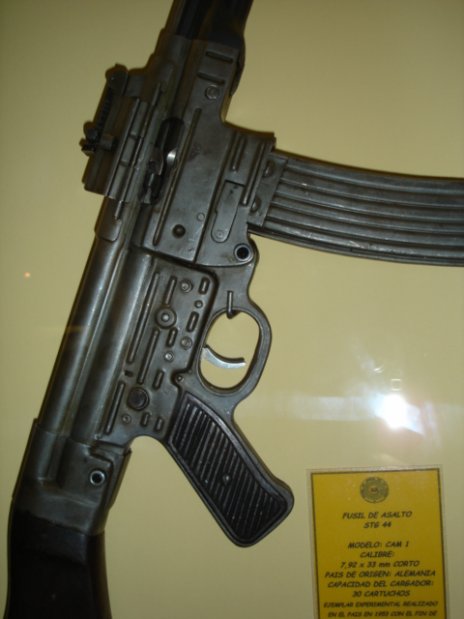
BD44 / PTR44 made by Sport Systeme
Dittrich
200 PTR44 were imported to USA by SSD in
Germany. The gun was / is labeled as BD44 in all other
countries. I understand that the PTR44 was assembled in
USA with some US made parts - and not all were heat
treated properly, which has caused some problems. The bolt and op-rod bolt
should preferably be replaced with original parts and the same can be said about the magazine!!
The main problem is the "fodder": No one makes a perfect
8mm kurz round. Hornady and Prvi are the only commercial
manufactures and even if one hand loads, there are no
powders identical to the WWII 8mm kurz powder.
BD44

PTR44
See below a PTR44 - a pretty close copy
of the ancestor - here with a rail for the ZF4 scope
mount.
Underneath receiver: fxo and cos but
no Nazi chicken!
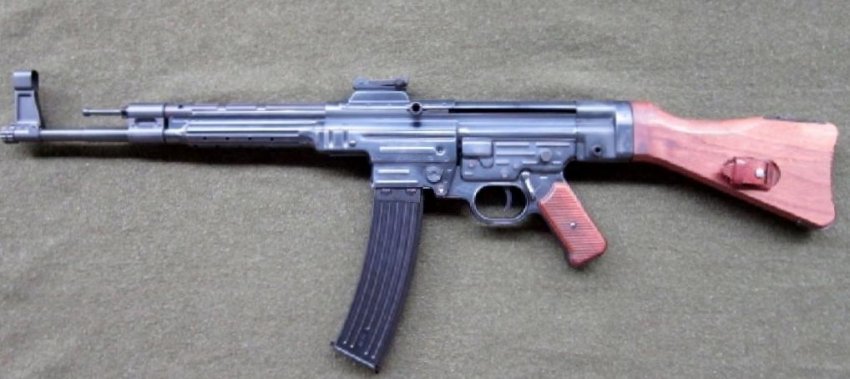

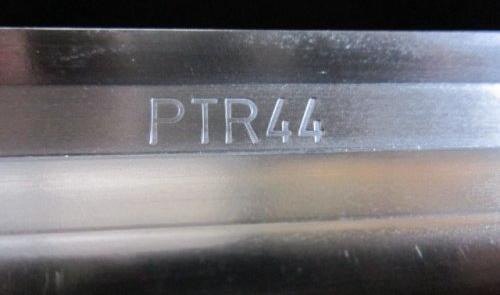
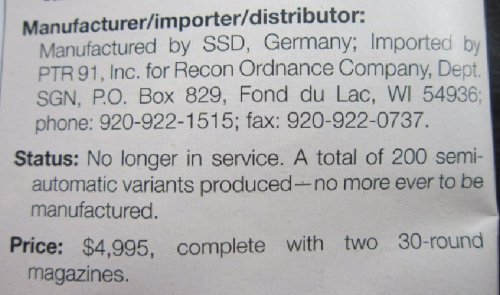

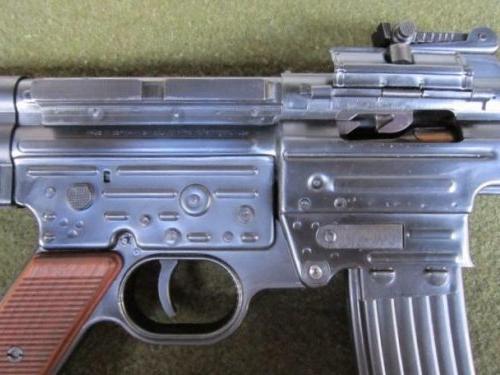
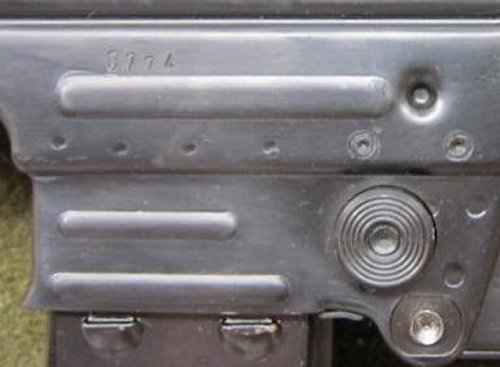
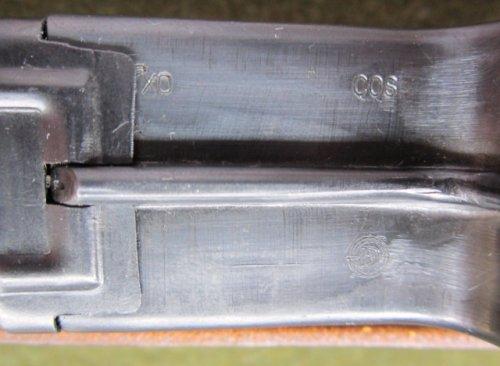
StG44 in cal .22
Produced by German Sporting Guns (in
Germany of course) in cal. 22LR. It's said it's very
well made and it shoots good also. The magazines have 2,
10, 15 or 25 rounds.
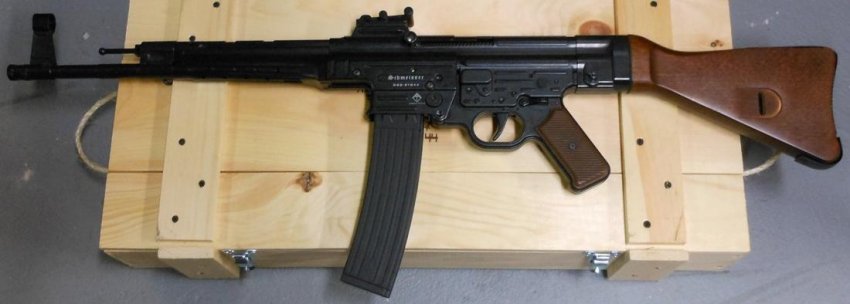
Differences
between the 6 factories which made the final assembly:
Haenel - code
fxo, WaA37
Haenel developed the whole concept and produced all
versions right from the beginning - Mkb42(H), MP43/1,
MP43, MP44 and StG44. About 185,000 were produced.
Haenel serial number letters are German Gothic script inspired type / normal lowercase letters -
sometimes 2 letters. See examples further down. Haenel barrels are marked with fxo and some
have a kind of serial number on them that has nothing to
do with the serial number of the gun. Haenel ceased the production in early April 1945 because the presence
of US troops in the Suhl-area. The same must be true for Sauer and Erma.
On underside of receiver forward of mag well: cos / WaAA44 (Merz
Werke), fxo (Haenel), WaA37 - twice (Haenel/Sauer) and a
Nazi-eagle (German army proof).

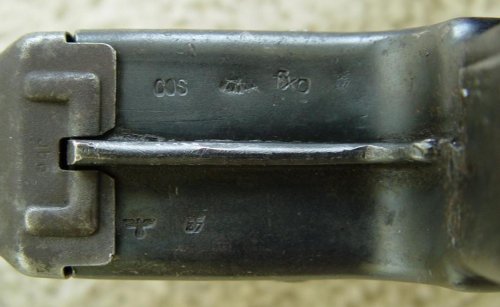
Steyr - codes
bnz / swj, WaA623
The whole Steyr production is designated MP44. 80,000
were made. The MP's have a muzzle nut and no scope
mount. The last were crudely made. Steyr produced most
of the parts themself incl. the receivers but not the trigger housings.
Steyr serial number letters are capital letters (966
I/XE can be misread as 9661/XE). XE means 1945. Steyr
barrels always have a Steyr "bnz" shield.
The first Steyr receivers were "normal", but note here below a simplified Steyr main housing - below
further again two "normal" receivers from Erma and Sauer. Steyr continued the production to the very end; that means in the beginning of May. The factory was
occupied on May 5. by American troops.
On underside of receiver forward of mag well: swj - or bnz (Steyr),
WaA623 (Steyr) and a Nazi-eagle (German army proof).
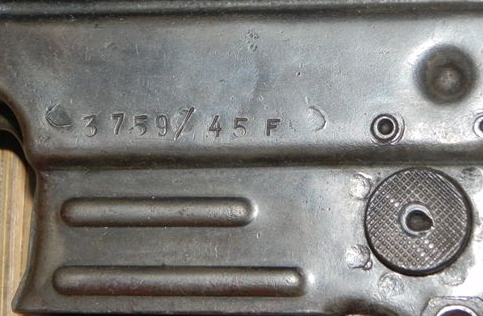 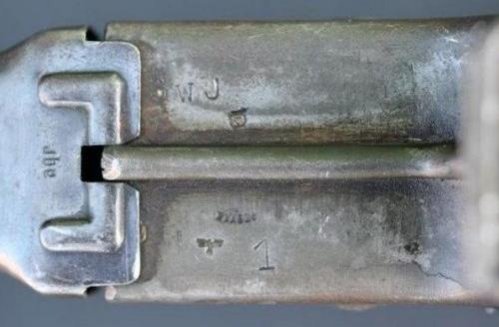
Erma - codes
ayf / qlv, WaA280
Erma produced MP43, MP44 and StG44. 104,000 were made.
Erma serial number letters are regular lowercase letters -
at last 2 letters. Erma barrels will have nothing more
than a letter such as "Q" or "S" and also have "ayf" or
"qlv".
On underside of receiver forward of the mag well: cos / WaAA44 (Merz
Werke), ayf or qlv (Erma), WaA280 (Erma) and a
Nazi-eagle (German army proof).
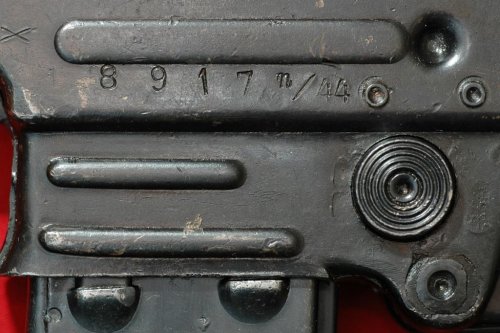


Hugo Schiffer - code afv,
WaA288
The number below should be: 9341ar/45 - not easy to see. The two pictures below are from the same gun. There exists
only the receiver today. Stamped MP44, not StG44 but very few are seen.
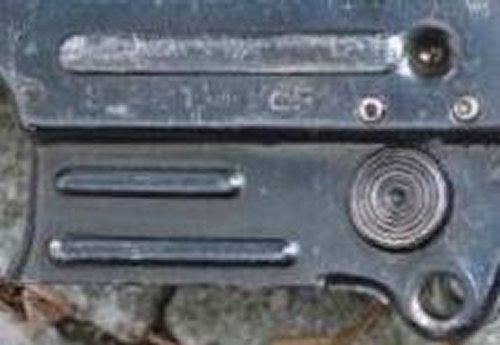
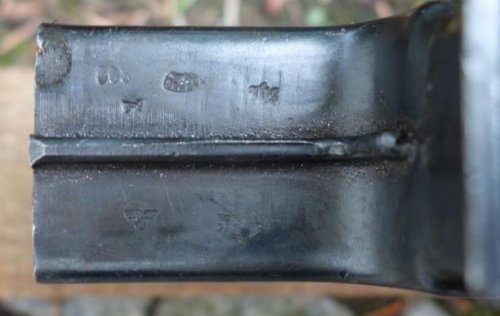
I think that the receiver above and the receiver below both are marked: "cos",
"WaAA44", "afv" and WaA288. "afv" is: Hugo Schiffer, Luedenscheid. The town is not far away from
Merz-Werke (cos). Peter Senich mentions in his book (p. 85) that Hugo Schiffer was a possible final assembler.
The reason for the shift may have been to replace final assembly sites to Luedenscheid away from Thuringia
which was threatened by Russion troops. The production at Hugo Schiffer was apparently not very large
and since the code "afv" is very close to Erma's code "qlv" and at the same time the WaA
number WaA288 is very close to Ermas WaA280, then there is a very likely possibility that one
thought that a certain MP44 had been assembled at Erma, where it was actually assembled at Hugo Schiffer.
Please contact me if you think you have seen a weapon that can have been made at Hugo Schiffer - afv, WaA288.
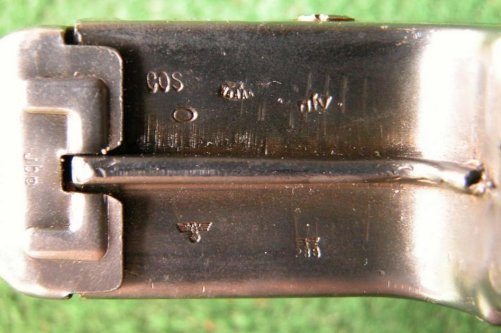
Sauer - code ce,
WaA37
Sauer produced MP43, MP44 and StG44. 55,000 were made.
Sauer serial number letters are regular lowercase letters -
at last 2 letters. Sauer barrels are always marked "ce".
On underside of receiver forward of mag well: cos / WaAA44 (Merz
Werke), ce (Sauer), WaA37 (Haenel/Sauer) and a
Nazi-eagle (German army proof).
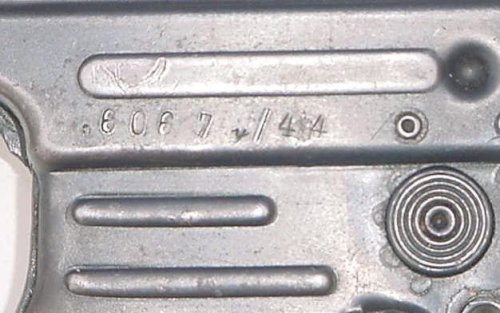

Mauser, Borsigwalde - code dd,
WaA1
Mauser produced StG44. Perhaps 2,000 were made - all in 1945?.
On underside of receiver forward of mag well: cos ? / WaA1, SUP and a
Nazi-eagle (German army proof).
Please contact me if you think you have seen a weapon with the code dd.
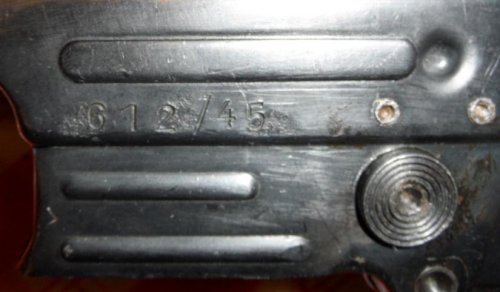
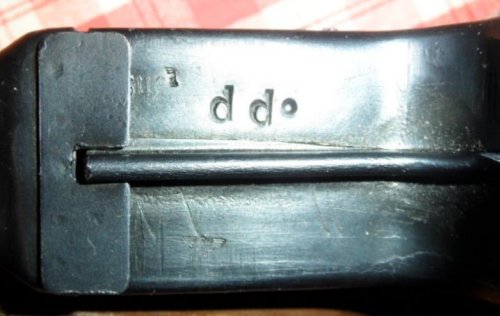
Mauser, Oberndorf - code
byf / svw, WaA135
Mauser produced receivers for Haenel, Erma and Sauer but
did not assemble the guns. Mauser made receivers are
marked with the code "byf" or "svw". Mauser receivers
are seen with small letters - sometimes capital letters
in Gothic style. (Who numbered the receivers - and how
was it ensured that the same number wasn't reused?).
On underside of receiver forward of mag well: byf (Mauser),
WaA135 (Mauser), fxo (Haenel), WaA37 (Haenel/Sauer) and
a Nazi-eagle (German army proof).
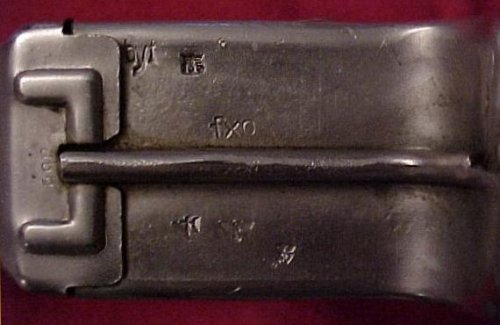
Deutsche Kühl- und Kraftmaschinen, Zschopau - code sup. / SUP
not so far from the Czech border. Foreign troope arrived Sauer, Haenel and Erma in the middle of April but never came to Zschopau before the war ended.
The DKK fabricated receiver housings till the end. From April 1945 on they acted also as assembly firm. Parts and personnel had been transferred from
Haenel/Suhl to Zschopau - including the WaA37 acceptance personnel.
Another interesting thing is that a batch of DKK receiver housings that were to be delivered to Haenel/Suhl were redirected to Steyr. That is the reason
why some of the weapons assembled by Steyr are stamped StG44 (and sup.) instead of MP44. (credits to Dieter Handrich) I have pictures
that show a receiver marked StG44 and SUP 5/5, but I am not allowed to publish them. It is the only case I have heard of a SUP reciver made in May 1945. Steyr may have had production in May 1945,
but I don't know when that production ended. The other factories stopped production in mid-April 1945.
Who made the complete receivers?
Haenel, code fxo, WaA37
One must assume that Haenel produced complete receivers right from the start, but Merz-Werke was already involved in the production of the MKb42.
Merz-Werke, code cos, WaAA44
Merz-Werke supplied receivers right from the start to the finish to Haenel, Erma and Sauer. Possibly also to Mauser, Borsigwalde.
Mauser, Oberndorf, code byf - at last svw, WaA135
Mauser made receivers around the last six months of the war to Haenel, Erma and Sauer.
Steyr, code bnz - later swj, WaA623
Steyr made their own receivers. The first (few) were called MP43, the rest MP44 - except for the very last ones from April 1945 which came from "sup." and they were marked StG44.
Deutsche Kühl- und Kraftmaschinen, code sup./SUP, WaA37
DKK made receivers for Haenel and Sauer from Dec. 1944 - possibly also for Mauser, Borsigwalde. From March 1945 also to Steyr. At the very end, they also assembled complete weapons with the help of personnel from Haenel and Sauer.
How was the type designation stamped?
The nomenclature was applied before the stamped steel receiver housing was bent around the receiver block. It will dent the metal if it was applied after the complete receiver was made. See the picture below:

The individual characters were applied one at a time. There exist stamps where the Impression of the characters have a different depth. There is no systematicity in the spacing between the characters.
Old German handwriting
One could assume that Hitler would prefer the old German type and handwriting, but that was not the case.
Already in 1934, he spoke in strong terms against this type. The Nazis decided in 1941 that the Ghotic script was too Jewish and as such should
be completely banned. It was at least the official reason, but the real reason was the Gothic font was unknown outside Germany,
which was unfortunate if Germany was to be the dominant power in Europe.
There are several versions of the old German handwriting. The last version
"Sutterlin Schrift" was taught in all German schools op to 1941 - see below:

Examples of Haenel letters:
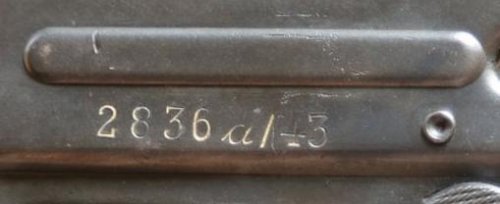 2836a - a normally written "a"
2836a - a normally written "a"
 8850b - a normally written "b" 8850b - a normally written "b"
 4743c - a normally written "c" 4743c - a normally written "c"
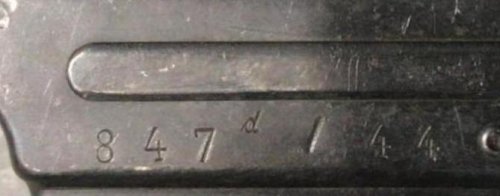 847d - a normally written "d" 847d - a normally written "d"
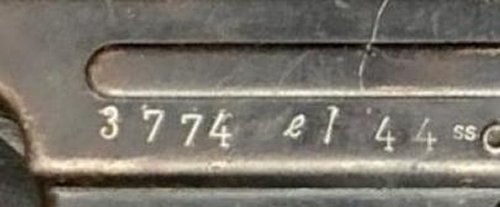 847d - a normally written "e" 847d - a normally written "e"
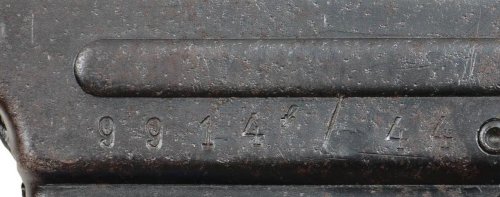 847d - a normally written "f" 847d - a normally written "f"
 7381g - a normally written "g" 7381g - a normally written "g"
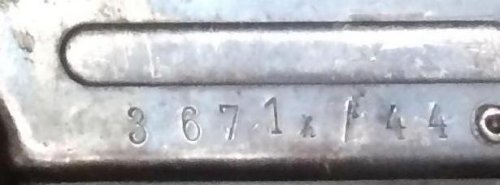 3671h - a normally written "h" 3671h - a normally written "h"
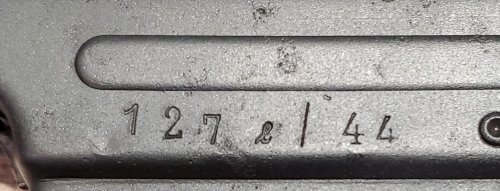 127 l - a normally written "l" or is it "e" ? 127 l - a normally written "l" or is it "e" ?
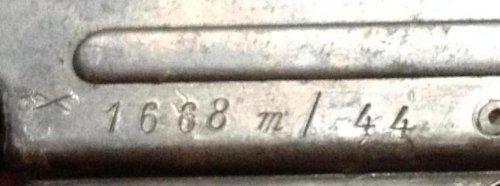 1668m - a normally written "m" 1668m - a normally written "m"
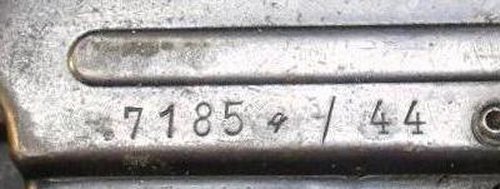 7185q - a normally written "q" - and "g"
are difficult to distinguish from "g" 7185q - a normally written "q" - and "g"
are difficult to distinguish from "g"
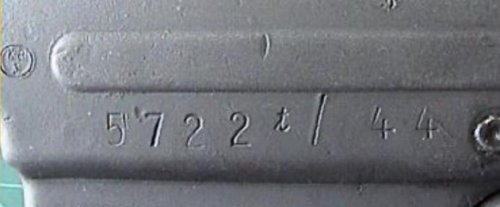 5722t - a normally written "t" 5722t - a normally written "t"
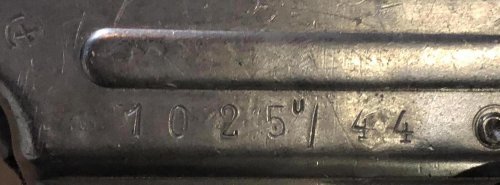 1025u - a normally printed "u" 1025u - a normally printed "u"
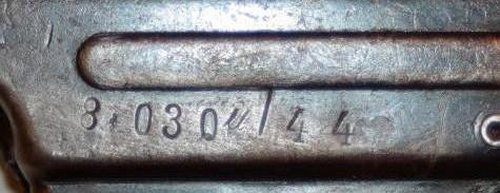 8030u - a normally written "u" 8030u - a normally written "u"
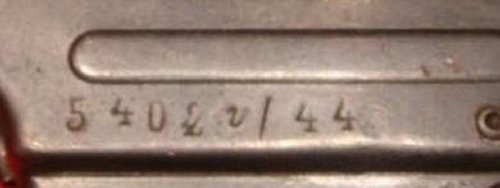 5402v - an almost normally written "v" 5402v - an almost normally written "v"
 8025w - a Ghotic "w" 8025w - a Ghotic "w"
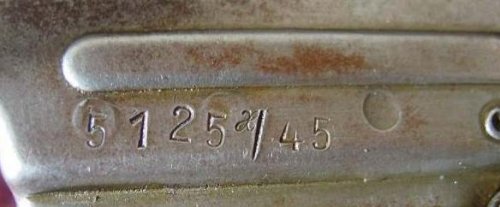 5125x - a Ghotic "x" 5125x - a Ghotic "x"
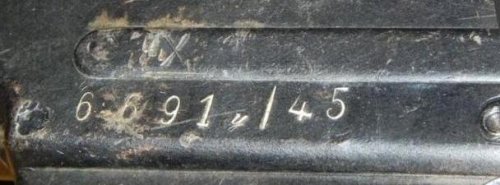 6691y - a normally written "y". See further up on this page a Sauer
assembled MP44 with number 6067y/44. Both factories were from the town Suhl, so it's reasonable
to imagine that the factories cooperated. They shared also the same WaA-inspector (37). 6691y - a normally written "y". See further up on this page a Sauer
assembled MP44 with number 6067y/44. Both factories were from the town Suhl, so it's reasonable
to imagine that the factories cooperated. They shared also the same WaA-inspector (37).
|
Letters
in the serial numbers:
Haenel: nothing, a, b, c, d, e, f, g, h,
k, l, m, n, q, s, t, u, v, w, x, y, ai, aj
Erma: i, k, n, o, r, s, z,
aa, ab, af
Hugo Schiffer: ar ?
Sauer: p, u, y, ab, ac, ad, ae,
ai, al
Steyr: nothing, A, B, C, D, E,
F, G, H, I, J (I not so tall)
Mauser, Borsigwalde: nothing /45
See a
picture of a large collection
I presume from USA - everything
is so vast there ! Below a part of a French collection.
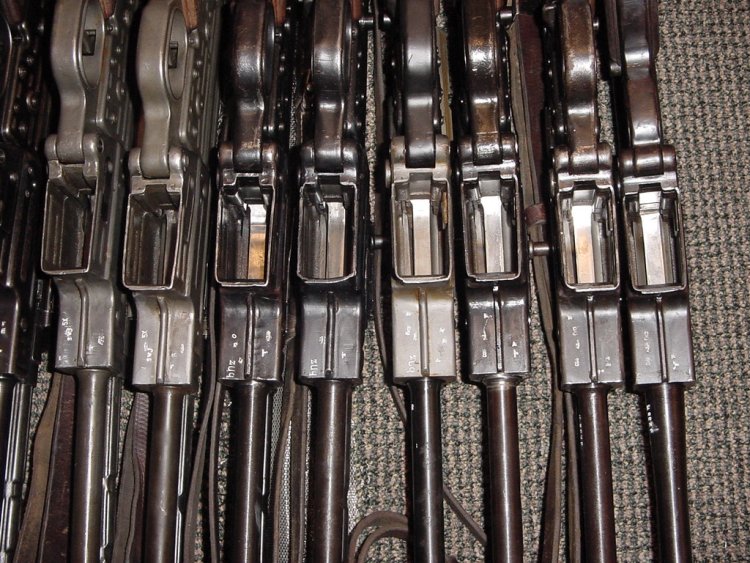
|
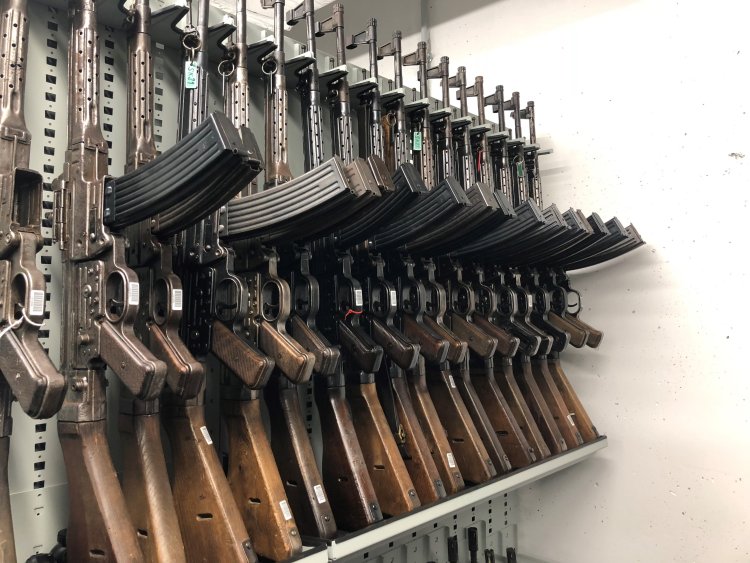
Who used the Sturmgewehrs? Where did they end?
The Eastern front
The top photo shows the first unauthorized use of German
hardware. When the German troops advanced in Russia they used to some extent Russian weapons such as the SVT40. The guns and ammunition
was readlily available. The same happened for the long trail for the Russians westward - they used German MP and StG. The partisans in Poland
and Ukraine used what they could get.
Next is a postcard to the family. I read on
the backside: We have a peaceful time here at the front.
We play accordion and on the Sundays we shoot for fun
our super rare MKb42(H).
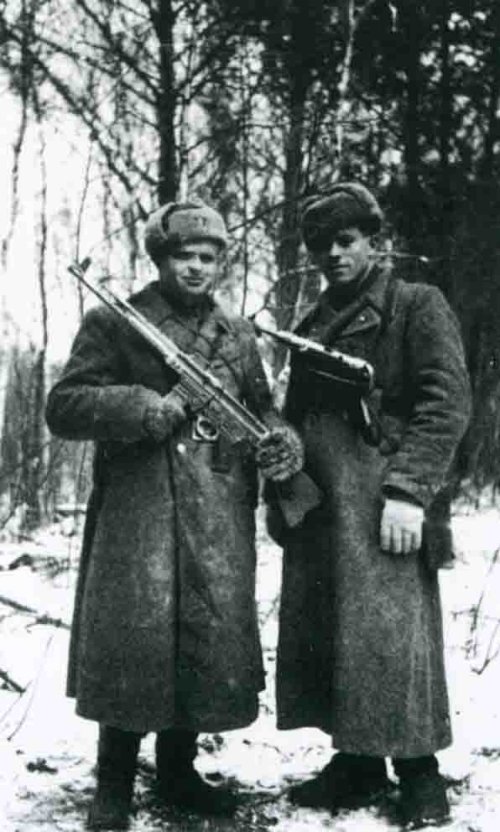

After the war
About 440,000 Mkb42 / MP43/1 / MP43 / MP44 / StG44 were
produced and a great proportion of them were destroyed in combat. In
Denmark for example were all previously German weapons
British property. They had no use for such weapons -
they had plenty of their own weapons - (albeit not in
the same quality, think of German tanks, submarines and
Sturmgewehrs), so all weapons were destroyed quickly. I
presume the same happened all over the Western front and
Italy. But not in Norway. Norway reused all kinds of
German handguns such as K98, P08, P38, MG34, MG42 and to
some extent the G43. But I don't think that the MP44 was
used by any troops. The ammunition was problematic and
they had too few MP44 because Norway wasn't given
priority for the Wehrmacht to the most modern handguns.
The Russians could use such hand weapons, so they
confiscated weapons and spare parts, this concerned also
G43, K98 and pistols, they were renovated and stored. They didn't use the MP/StG44's themself
but handed them over to other East Bloc states such as DDR and perhaps also to
Czechoslovakia and Yugoslavia.
The guess is that more than 100,000 MP44 existed in the Eastern block in the late forties. Where
did these end up?
Czechoslovakia to the early fifties
The Czech's had many MP/StG44 left over from the more than 800,000 troops ended there by the armistice in May 1945. They made ammo for them from 1945 to 1946.
The guns were still in service at the time of the State Funeral of
Masaryk in 1948, just about the time of the communist take over. Some sources say that Czechoslovakia
had more than 20,000 guns in stock in 1950.
After that, with the adoption of the VZ52 and VZ58, the Sturmgewehrs (Samopal in Czech) were relegated to
reserve and training use or export to "friendly states in Africa and the Middle East". The Libanese Forces indicate for
example they had used the MP44/StG4 rifles.The Czechs supplied a lot of either reconditioned or new ex-WW2 firearms
to DDR from 1950 to about 1960 + ammo to match.
DDR to the early sixties
A systematic use of the MP44 was in Eastern Germany, where
die Volkspolizei (the People's Police) used the MP44; The VoPo-name was used from 1946 and
consisted of former Wehrmacht soldiers converted to communism. By Nov. 1946 the VoPo had more than 45,000 men, and in the same month the border police
was created with 3,000 men. In Dec. 1946 the transportpolizei was established. The forces were organized and equipped as light infantery. Later the regular army was
equipped with MP44's. DDR produced kurz up to 1961 so it
must be presumed that they also used the guns up to the
beginning of the sixties. See below a photo from DDR -
Barracked People's Police - this force preceded the "People's Army" created
on March 1, 1956.
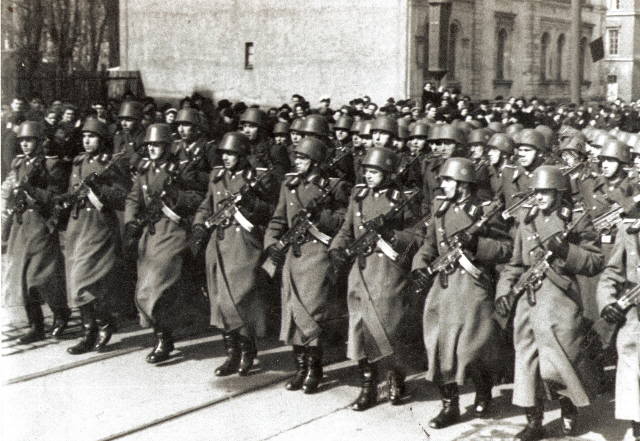
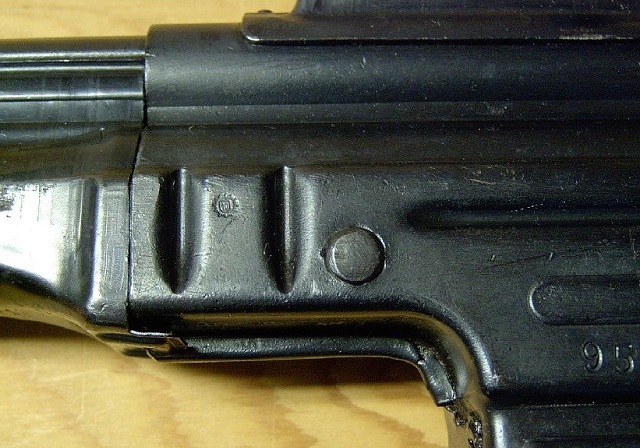
See above a "sunburst" marking. A number - here 10 - within a sunburst proof. The number must
indicate in which district the gun was used or perhaps which person accepted it. I have also seen "20", "22" and "25". The sunburst is also seen on K98k, G43,
P38 and P08. More information is welcome.

See above a "large cross" on the receiver. This indicates a DDR rebuild. Many of the guns were reblued, mismatching or renumbered.
Yugoslavia to the early eighties
One of the more extensively and systematic uses of the
MP44 after the war, was in the Yugoslavian army, where
it's said that 63rd paratroop battalion used the MP44 as
the main handgun up to 1983. I am told that Tito gave
Mr. Gadaffi (Libya) 40,000 MP44´s which trickled out to
other countries.
Perhaps not much used in the last years. They used
German made ammo - so they didn't produce normal kurz
themself, but Yugoslavian made blank cartridges and
rifle grenade cartridges are seen. - made in 1983. Dr.
Dieter Kapell mentions this in his book "Die Patrone
8x33".
I have been told that two 40* containers arrived to London in 1994-95 with more
than 2,000 MP44 from Ex-Yugoslavia. There were only two MKb42. A MP43/1 was marked on the stock with a SS skull
and ssza4 on the metal parts.
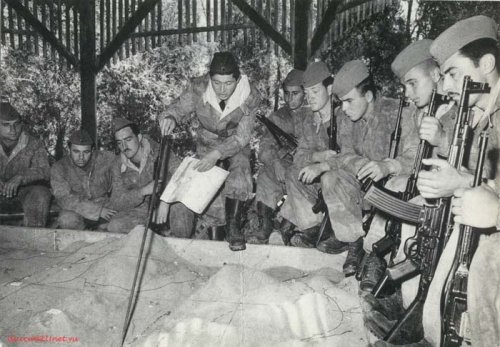
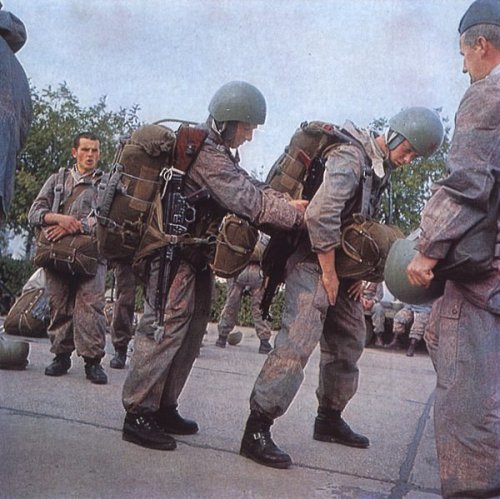
The middle East
Recent rumors tell that the Syrian rebels have captured
4000 or 5000 MP44 with all accessories, magazines etc.
but NO ammo. They should be reworked DDR stuff. The ammo
has always have been the problem for the MP44, as the
kurz hasn't been made since 1961 and up to about 10
years ago. Even the Wehrmacht was constantly in short
supply with ammo on the Eastern front.
Northern Africa
This interesting picture shows MP44's
captured by the French Army during the Algerian war
(1954 - 62). Most of these weapons were shipped from
Czechoslovakia or Yugoslavia. Normally not blued but
phosphated. My "correspondent" has also seen fine MP44's
in Syria and Lebanon and some very bad in Somalia. The
last brand new he saw, in original wooden box with Nazi
eagle marked on the box, never used, was in Burkina
Faso. Earlier called: République de Haute-Volta (we all
know where this is? (humph!))
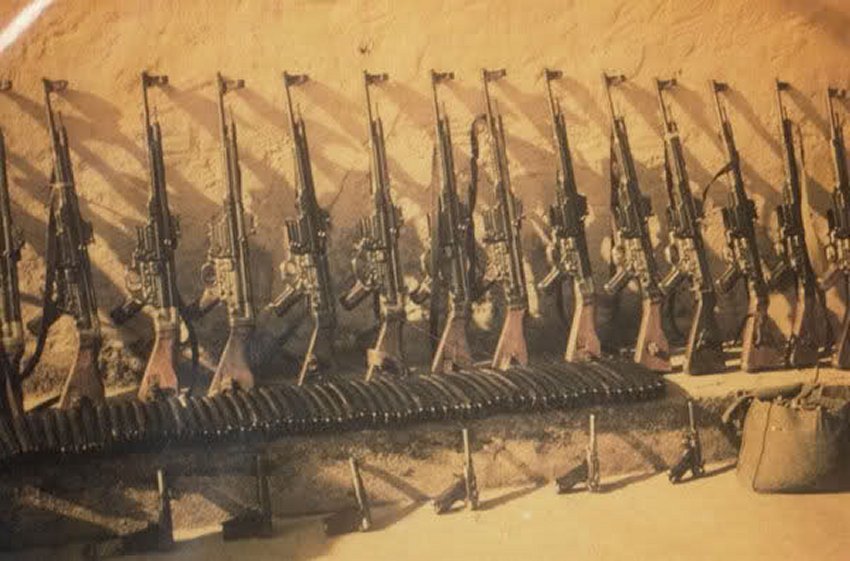
Somalia
Women of the West Somali liberation
front express their support for Somalia during the war
against Ethiopia for the border territory of the Ogaden
1977 - 78. Was the gun really loaded? If it had been
today, she could have bought a AK47, 3 goats and a new
man for her MP44.
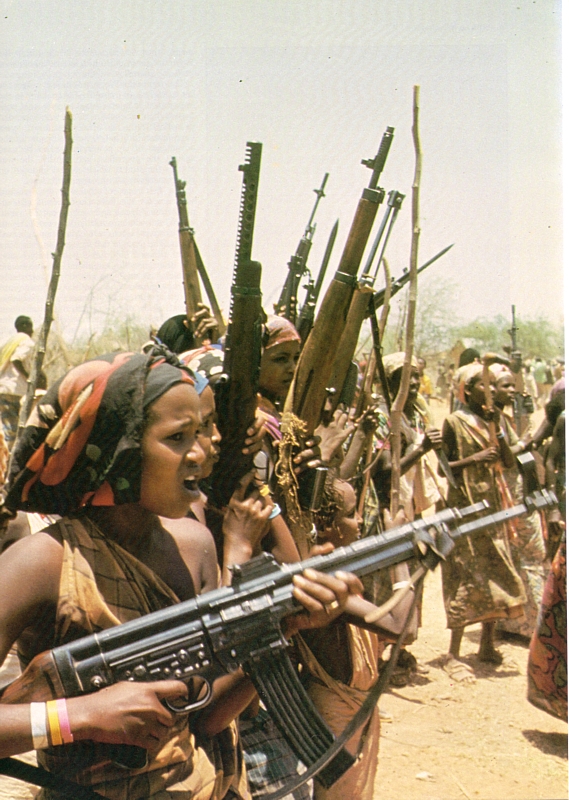
|
|
|



























 Above a ZF4 marked for use with kurz round. I am not
sure about the origin of the mount. A special ZF4 was used
for the "kurz Patrone" (because of different trajectory). See below two photos of a "P" scope. Note that the elevation knob
has a maximum of 600m versus the normal 800m. The marking: Kurz Patr. Nr.00XX is not believed to be genuine.
Above a ZF4 marked for use with kurz round. I am not
sure about the origin of the mount. A special ZF4 was used
for the "kurz Patrone" (because of different trajectory). See below two photos of a "P" scope. Note that the elevation knob
has a maximum of 600m versus the normal 800m. The marking: Kurz Patr. Nr.00XX is not believed to be genuine.




















































































 2836a - a normally written "a"
2836a - a normally written "a" 8850b - a normally written "b"
8850b - a normally written "b"
 4743c - a normally written "c"
4743c - a normally written "c"
 847d - a normally written "d"
847d - a normally written "d"
 847d - a normally written "e"
847d - a normally written "e"
 847d - a normally written "f"
847d - a normally written "f"
 7381g - a normally written "g"
7381g - a normally written "g"
 3671h - a normally written "h"
3671h - a normally written "h"
 127 l - a normally written "l" or is it "e" ?
127 l - a normally written "l" or is it "e" ?
 1668m - a normally written "m"
1668m - a normally written "m"
 7185q - a normally written "q" - and "g"
are difficult to distinguish from "g"
7185q - a normally written "q" - and "g"
are difficult to distinguish from "g" 5722t - a normally written "t"
5722t - a normally written "t"
 1025u - a normally printed "u"
1025u - a normally printed "u"
 8030u - a normally written "u"
8030u - a normally written "u"
 5402v - an almost normally written "v"
5402v - an almost normally written "v"
 8025w - a Ghotic "w"
8025w - a Ghotic "w"
 5125x - a Ghotic "x"
5125x - a Ghotic "x"
 6691y - a normally written "y". See further up on this page a Sauer
assembled MP44 with number 6067y/44. Both factories were from the town Suhl, so it's reasonable
to imagine that the factories cooperated. They shared also the same WaA-inspector (37).
6691y - a normally written "y". See further up on this page a Sauer
assembled MP44 with number 6067y/44. Both factories were from the town Suhl, so it's reasonable
to imagine that the factories cooperated. They shared also the same WaA-inspector (37).










